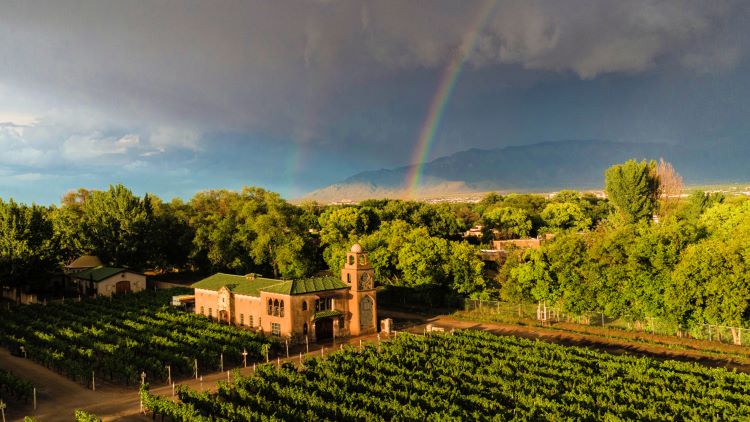Get to Know New Mexico as a Wine Region and its Wines
Welcome to the most current and comprehensive guide to New Mexico as a wine region, along with its wines and wineries.
When Spanish colonists arrived almost 400 years ago, they brought European vines and planted them in the fertile soils of the Rio Grande Valley. That makes New Mexico the oldest wine-producing region in the country.
Today, grape growers still plant along parts of the Rio Grande, the fourth-longest river in the country, which ripples through the state from north to south.
New Mexico ranks as the nation’s fifth-largest state—indeed, the state is so vast that you’ll find nearly every world vegetation zone there. As a result, New Mexican vineyards produce a wide variety of grapes.
Further, New Mexico’s rare mix of Spanish, Native American and Old West Americana make for a blend of culture reflected in the region’s iconic adobe architecture, food and wine that travelers find nowhere else in the US.
RELATED: These Are Our Top Picks for the Best Wineries to Visit in New Mexico
Get ready for a flavor adventure—each New Mexico offers a unique lineup of varietals to explore!

Diversity of Grapes Due to Environmental Conditions in New Mexico
“There is not just one grape that reflects the state. So, vineyards are growing different grapes and producing a wide range of wines,” explains New Mexico Wine President Sam Aragon. His family owns Las Nueve Ninas Winery, one of New Mexico’s most northerly vineyards that produces high-altitude wines.
“New Mexico’s environmental conditions are some of the most difficult. We’re similar to Mendoza [Argentina] with high altitude and dry, cold winters,” adds viticulturalist Bernd Maier, who manages over 70 acres on some of New Mexico’s most southerly vineyards. Southern New Mexico’s scorching days and really cold nights make for tremendous but challenging growing conditions on the floodplains of the Rio Grande.
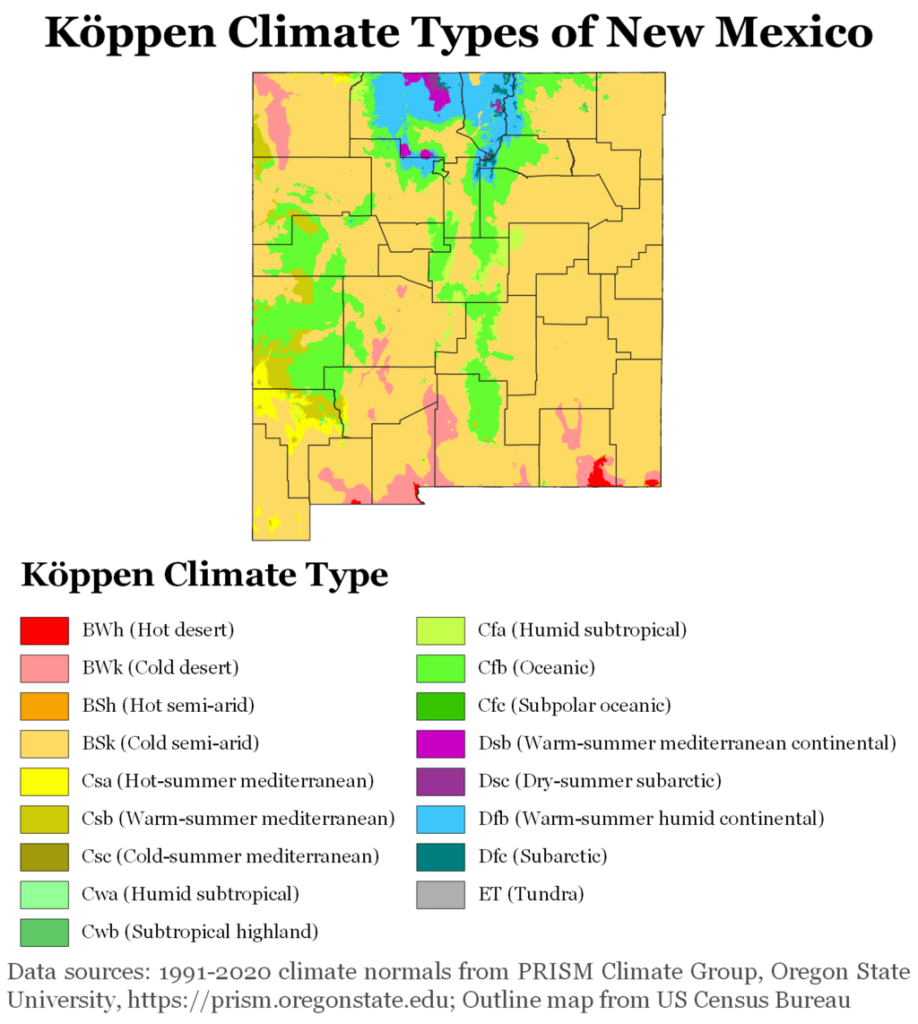
“We’re constantly evaluating what may grow under the conditions we have here,” says Bernd. In doing so, New Mexico vintners try a wide range of varieties from around the world.
“The results we’ve seen in awards prove that we can grow and we can make wine,” he smiles.
Overview of the Viticultural Legacy of New Mexico
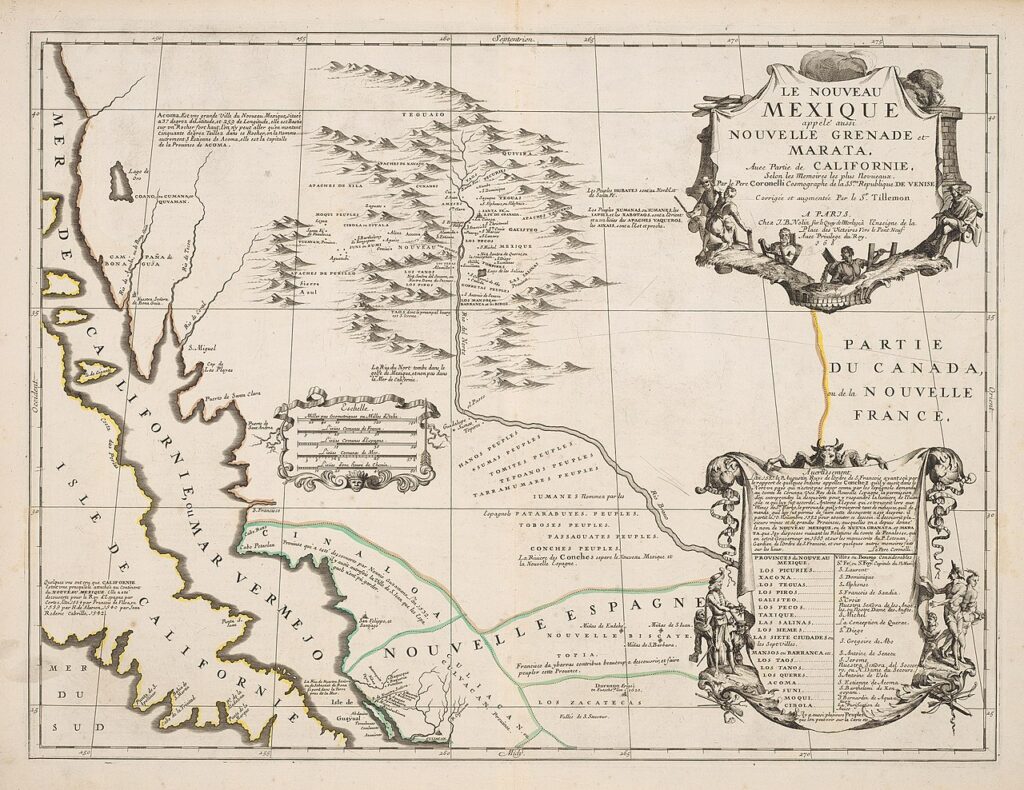
In 1629, Spanish clergy planted Spanish vines at a mission on the west side of the Rio Grande just south of present-day Socorro.
Known throughout the Southwest as “Mission grapes,” these grapes were initially used to create sacramental wine for the Eucharist. Interestingly, this was two centuries before the planting of vinifera vines in California’s Napa Valley, earning New Mexico the title of the oldest wine-producing area in the United States.
The Spanish Roots of New Mexico’s Viticulture

Two Franciscans, fray Garcia de Zúñiga and Antonio de Arteaga (Ortega), a Capuchin monk, were credited with bringing the first vines to New Mexico. They planted them at the Senecú Pueblo, south of Socorro, in 1629. The Piro people lived in the pueblo that had been visited by Juan de Oñate, the first colonial governor of the Province of Santa Fe de Nuevo México, in 1598.
According to legend, Zúñiga and Arteaga daringly smuggled vines out of Spain, flouting the Spanish Crown’s ban on exporting vines to the New World. The tale suggests that the King was keen on preserving the tax revenue from Spanish wine shipped overseas. For those familiar with the Boston Tea Party, the idea of skirting taxes through smuggling has a certain romantic allure.
However, recent research brings to light that the Spanish prohibition of planting vines in South America did not apply to New Spain, of which New Mexico was part.
RELATED: Top Wineries & Vineyard Resorts to Visit in Spain
In fact, Columbus brought vines with him to the New World, and 75 years before the Catholic duo brought vines to New Mexico, a viticulture industry was already established in Peru.
Either way—smuggled or not—the Franciscans’ vines produced grapes and sacramental wine at Senecú Pueblo, and the Spanish mission built there for more than forty years.
But since then, New Mexico wines, like all products, have had their ups and downs.
Heydays of the 1880s
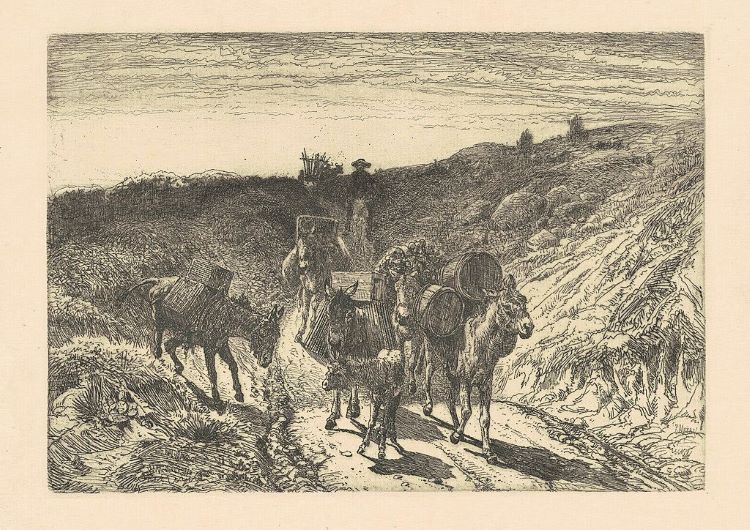
Mission grapes were the leading winemaking grape in New Mexico, Arizona and California up to the late 1800s, according to Arizona historian Erik Berg. “It’s pretty likely that Billy the Kid drank the Mission grape,” he reports.
The so-called Mission grapes of the Spanish variety, Listán Prieto, are known for their generous size in both berries and bunches. This results in a higher juice-to-skin ratio, which imparts a pale red color to the wine, along with mild acidity and balanced tannins.
By 1880, the year Billy the Kid, the notorious gunfighter, was jailed, New Mexico wine producers were in their glory days. Producing nearly a million gallons, they ranked fifth in the nation’s wine output.
However, uncontrolled Rio Grande flood waters destroyed vineyards, properties and irrigation canals in the following years. Besides decimating floods, some historians cite factors such as new “gringo” management and increasing California wine production for the sudden decline.
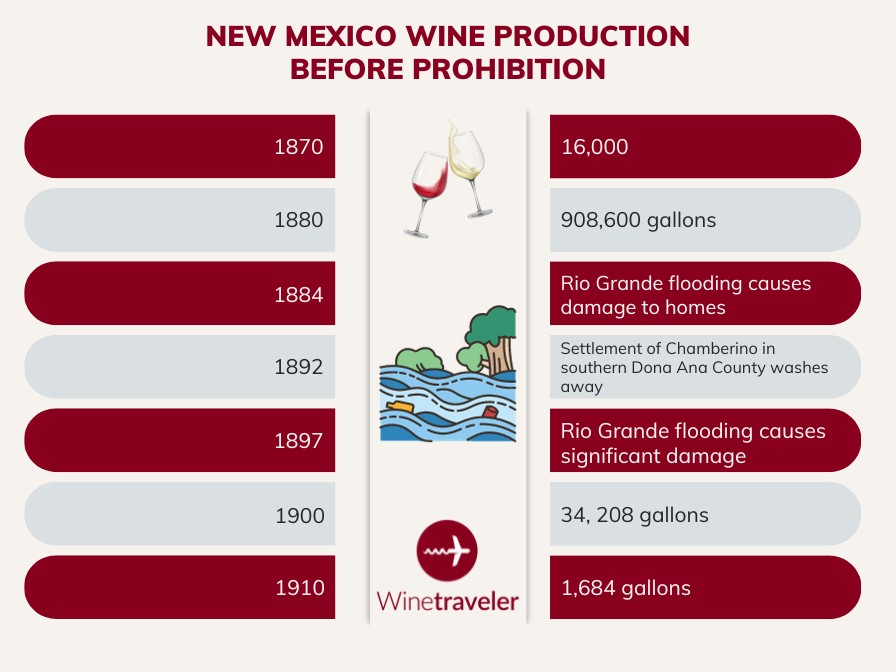
Prohibition and Its Impact on New Mexico’s Wine Industry
National Prohibition of 1920-1933 put the final nail into the coffin of the heyday of New Mexico wine production. Although some winemakers continued to produce sacramental wine, which remained legal, the wine industry never fully recovered from the floods and Prohibition.
It would take 50 years for the New Mexico wine industry to gain traction again.
The Revival and Rise of Modern New Mexico Wineries
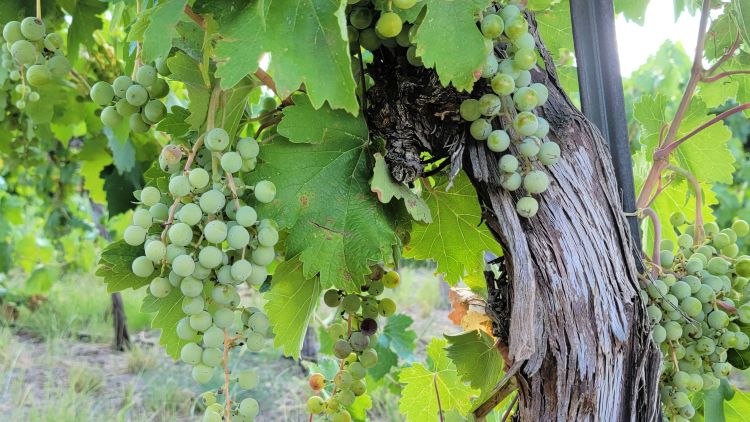
“With such a dynamic, extensive history of winemaking in New Mexico, it’s easy to fixate on the past. Much like the vines themselves, we have turned every adversity into resilience, and these struggles have allowed us to establish deep roots and embed wine into our cultural fabric,” says Chris Goblet, Executive Director of New Mexico Wine.
New Mexico now has 55 wineries producing 749,818 US gallons/2,838,370 liters of wine annually.
“The people of New Mexico generally know the history of grapes in our state, but for the rest of the country and the world, it is still one of the great wine stories that have yet to be told, and the upcoming 400th anniversary will give us this opportunity.”
Wineries are already preparing for the 400th anniversary of wine in New Mexico by planting new vineyards, blending commemorative wines and storing some of the finer vintages to break out in 2029.
“We created a tagline to celebrate the upcoming milestone to share our excitement, VIVA VINO, which is more than just a slogan,” Chris declares. “It’s our collective spirit, a toast that invites people to celebrate with us, and a promise that we will be here for another 400 years to come.”
After this fascinating dive into New Mexico’s winemaking history, let’s move on to the regions, and ultimately the wineries that keep this tradition alive and flourishing.
The Wine Regions of New Mexico
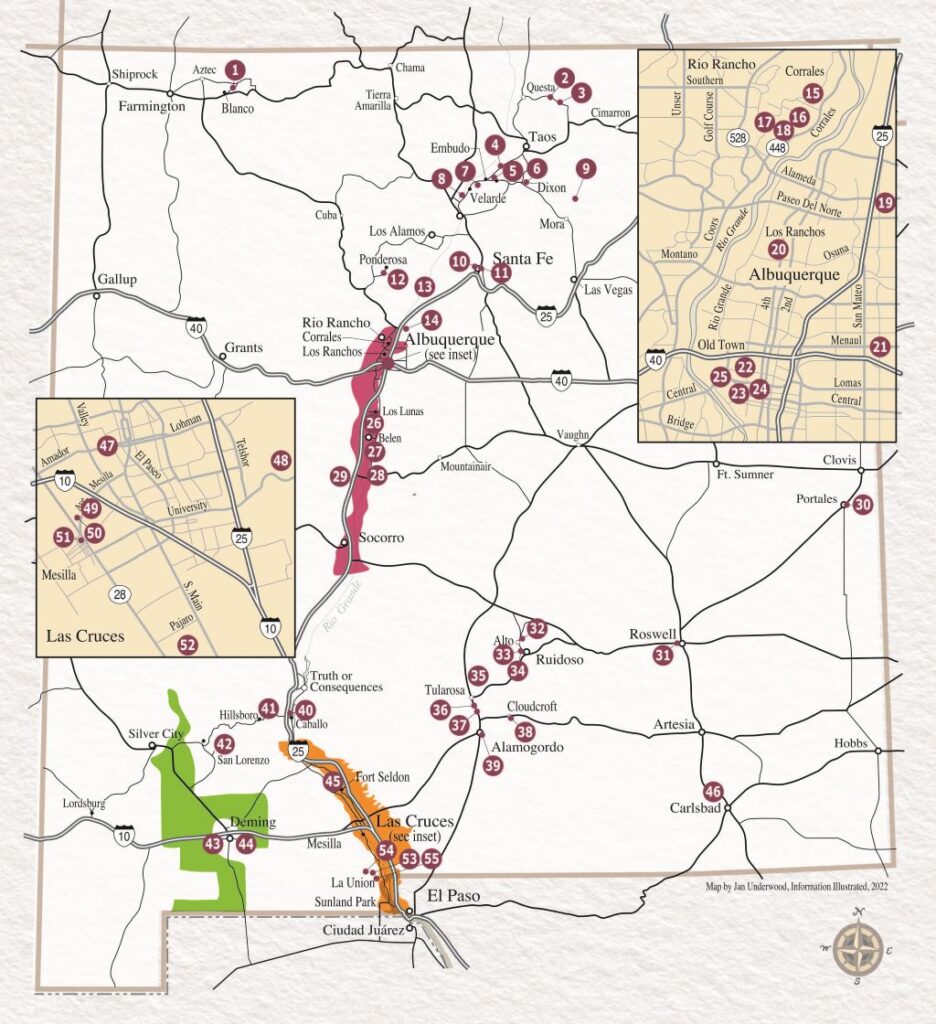
Wineries are advantageously clustered in six primary regions throughout the state, making New Mexico an intriguing destination for oenophiles. Each area presents a unique terroir and microclimate, enabling winemakers to craft a diverse range of wines that reflect the land’s history, culture and evolving palate of modern-day wine enthusiasts. They include:
Albuquerque – Middle Rio Grande Valley AVA
Belen – Middle Rio Grande Valley AVA
Santa Fe
Las Cruces – Mesilla Valley AVA
Alamogordo and Ruidoso
Deming – Mimbres Valley AVA
Now that you’ve taken a deep dive into understanding the wine regions of New Mexico, it’s time to visit! Our travel guide featuring the best wineries in New Mexico offers an in-depth exploration of each of its wine regions. It’s loaded with invaluable tips on transportation, lodging, tasting rooms, winemaker interviews and so much more. Cheers to your next vinous adventure in New Mexico!
Pin This Article on Pinterest for Later

You are reading “Learn All About the New Mexico Wine Region”: Back To Top
Featured image Casa Rondena in New Mexico, courtesy Colibri Media
If you enjoyed this guide, consider joining the Facebook Group to interact with other Winetravelers and for wine travel inspiration around the world. Be sure to follow us on both Twitter and Instagram to stay up to date with our trending content.
